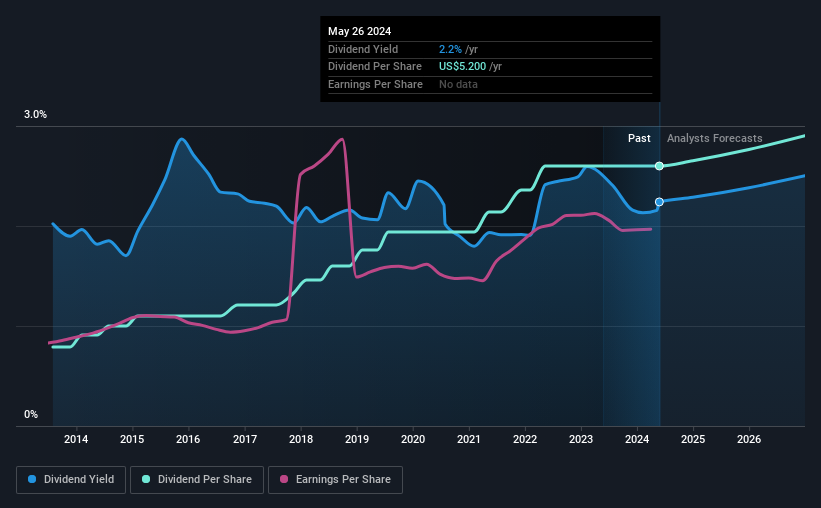- United States
- /
- Transportation
- /
- NYSE:UNP
Interested In Union Pacific's (NYSE:UNP) Upcoming US$1.30 Dividend? You Have Four Days Left

Union Pacific Corporation (NYSE:UNP) is about to trade ex-dividend in the next 4 days. The ex-dividend date is usually set to be one business day before the record date which is the cut-off date on which you must be present on the company's books as a shareholder in order to receive the dividend. The ex-dividend date is important because any transaction on a stock needs to have been settled before the record date in order to be eligible for a dividend. Thus, you can purchase Union Pacific's shares before the 31st of May in order to receive the dividend, which the company will pay on the 28th of June.
The company's next dividend payment will be US$1.30 per share, on the back of last year when the company paid a total of US$5.20 to shareholders. Looking at the last 12 months of distributions, Union Pacific has a trailing yield of approximately 2.2% on its current stock price of US$232.05. If you buy this business for its dividend, you should have an idea of whether Union Pacific's dividend is reliable and sustainable. So we need to check whether the dividend payments are covered, and if earnings are growing.
Check out our latest analysis for Union Pacific
If a company pays out more in dividends than it earned, then the dividend might become unsustainable - hardly an ideal situation. Union Pacific paid out a comfortable 50% of its profit last year. Yet cash flow is typically more important than profit for assessing dividend sustainability, so we should always check if the company generated enough cash to afford its dividend. It paid out more than half (63%) of its free cash flow in the past year, which is within an average range for most companies.
It's encouraging to see that the dividend is covered by both profit and cash flow. This generally suggests the dividend is sustainable, as long as earnings don't drop precipitously.
Click here to see the company's payout ratio, plus analyst estimates of its future dividends.

Have Earnings And Dividends Been Growing?
Stocks in companies that generate sustainable earnings growth often make the best dividend prospects, as it is easier to lift the dividend when earnings are rising. If earnings fall far enough, the company could be forced to cut its dividend. With that in mind, we're encouraged by the steady growth at Union Pacific, with earnings per share up 5.7% on average over the last five years. Decent historical earnings per share growth suggests Union Pacific has been effectively growing value for shareholders. However, it's now paying out more than half its earnings as dividends. If management lifts the payout ratio further, we'd take this as a tacit signal that the company's growth prospects are slowing.
The main way most investors will assess a company's dividend prospects is by checking the historical rate of dividend growth. In the past 10 years, Union Pacific has increased its dividend at approximately 13% a year on average. It's encouraging to see the company lifting dividends while earnings are growing, suggesting at least some corporate interest in rewarding shareholders.
To Sum It Up
Should investors buy Union Pacific for the upcoming dividend? Earnings per share growth has been modest, and it's interesting that Union Pacific is paying out less than half of its earnings and more than half its cash flow to shareholders in the form of dividends. In summary, it's hard to get excited about Union Pacific from a dividend perspective.
On that note, you'll want to research what risks Union Pacific is facing. Case in point: We've spotted 1 warning sign for Union Pacific you should be aware of.
Generally, we wouldn't recommend just buying the first dividend stock you see. Here's a curated list of interesting stocks that are strong dividend payers.
If you're looking to trade Union Pacific, open an account with the lowest-cost platform trusted by professionals, Interactive Brokers.
With clients in over 200 countries and territories, and access to 160 markets, IBKR lets you trade stocks, options, futures, forex, bonds and funds from a single integrated account.
Enjoy no hidden fees, no account minimums, and FX conversion rates as low as 0.03%, far better than what most brokers offer.
Sponsored ContentNew: AI Stock Screener & Alerts
Our new AI Stock Screener scans the market every day to uncover opportunities.
• Dividend Powerhouses (3%+ Yield)
• Undervalued Small Caps with Insider Buying
• High growth Tech and AI Companies
Or build your own from over 50 metrics.
Have feedback on this article? Concerned about the content? Get in touch with us directly. Alternatively, email editorial-team (at) simplywallst.com.
This article by Simply Wall St is general in nature. We provide commentary based on historical data and analyst forecasts only using an unbiased methodology and our articles are not intended to be financial advice. It does not constitute a recommendation to buy or sell any stock, and does not take account of your objectives, or your financial situation. We aim to bring you long-term focused analysis driven by fundamental data. Note that our analysis may not factor in the latest price-sensitive company announcements or qualitative material. Simply Wall St has no position in any stocks mentioned.
About NYSE:UNP
Union Pacific
Through its subsidiary, Union Pacific Railroad Company, operates in the railroad business in the United States.
Solid track record established dividend payer.
Similar Companies
Market Insights
Community Narratives


